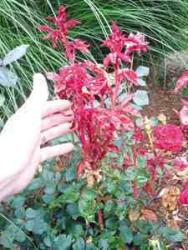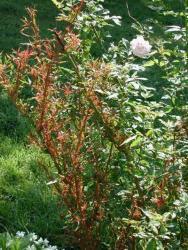During my 2nd year here, I noticed odd-looking new growth on Tess of the d'Urbervilles, a David Austin rose. The new growth on one cane was particularly deep red, more so than the typical red coloration of new growth, and it had so many thorns that it looked almost hairy. At first I just observed, and the growth became increasingly deformed and twisted.
Searching the Internet for the cause, I soon came upon photos showing the same deformed growth, symptoms of a viral disease called Rose Rosette Disease (RRD, or sometimes RRV, Rose Rosette Virus). The disease is spread by an eriophyid mite known as rose leaf curl mite, Phyllacoptes fructiphylus. These mites are not visible to the naked eye and can only be seen through a microscope. While they cannot fly, they can crawl from one plant to another if the plants are touching, and worst of all, they are carried on air currents for long distances. They can also hitch a ride on visiting insects.
Miticides used for the control of spider mites are not effective for controlling rose leaf curl mite. Three miticides (Avid, Akari and Judo) along with horticultural oil have been listed as controls in Conard-Pyle’s Rose Rosette Disease Guide. Use of these products is recommended for commercial rose growers, in rotation, so that the mites do not develop resistance.
The symptoms of the disease can vary from one variety of rose to the next. Symptoms may present in the following ways:
1.Increased growth and/or rapid elongation of shoots
2.Abnormal red discoloration of new shoots and leaves
3.Prolific clustering of growth, known as "witches' broom"
4.Shorter stem length between leaves
5.Spiral pattern in cane growth
6.Dwarfed and/or distorted leaves
7.Overabundance of thorns
8.Deformed buds and flowers
9.Mottled or atypical flower coloration
10.Increased susceptibility to other diseases
11.Decreased winter hardiness
RRD is systemic, meaning that it invades all of the plant's tissues through the vascular system. Some sources say that if symptoms are only showing on one cane, the prompt removal of the infected cane can save the plant, but otherwise the disease is incurable. I tried this with Tess of the d'Urbervilles, but within a few weeks more distorted growth presented itself. I then followed the advice from multiple sources to remove the plant entirely. The infected plant should be either burned or placed in plastic bags and disposed of immediately. For the next 5 years, I saw most of my roses picked off one by one. Each time I tried removing the infected part of the plant, but in all but one case, the symptoms returned, and the plants were then removed and burned.
It took a few years, but I finally found the "Typhoid Mary," an infected multiflora that was hidden, growing up the trunk of a blue spruce, as well as a couple of other infected multifloras growing in a nearby fencerow. From the 1930s to the 1960s Rosa multiflora was recommended for erosion control and as living livestock fences by the U.S. Soil Conservation Service. It has since been listed as an exotic invasive and noxious weed in many states in the midwest and the eastern parts of the United States. Multifloras are particularly susceptible to RRD and have become the primary host and source of the virus.
While the rampant growth of multifloras is more problematic in rural areas, another culprit has brought the issue to populated areas: the Knock Out Rose. While the Knock Out series is known for being highly resistant to fungal diseases, these roses are also highly susceptible to RRD. These easily grown plants have become popular among homeowners and for commercial plantings, meaning that a lot of people who are not gardeners are growing them, and many are unaware when the plants become infected.
After 7 years of diligently removing infected plants, I stopped seeing new signs of infection. The last plant to show symptoms was Folksinger, a Dr. Buck hybrid. One small tip of one cane had witches' broom growth, which I promptly removed, and that plant has now appeared healthy for over a year. This was my only success at saving a rose with RRD. While pruning, I make sure to carry a container of bleach solution with me, and I dip the pruners into it before each new cut.
Having gone over a year without any new signs of infection, I am now adding roses to my gardens again. While I'm breathing a sigh of relief at home, I'm very concerned about what this disease means for the future of rose growers. My home situation is different from many, as I live on an 18-acre piece of farmland, with no neighbors within sight. While I do have to be watchful with the multifloras, at least I don't have the concern of neighbors or nearby busnesses unknowingly harboring infected plants. I recently corresponded with a gardener who saw infected Knock Out plants at a nursery, among hundreds of other potted roses, and another who had to go through a year of hassle to convince the management of two nearby businesses to remove their infected plants.
There is a glimmer of hope on the horizon! Some American species of roses are showing resistance. Work has already begun in introducing these resistant genes to ornamental roses, but it will be years down the road before we start seeing those results.



| Thread Title | Last Reply | Replies |
|---|---|---|
| rrd by WendyLeeBee | Sep 9, 2023 8:13 AM | 0 |
| Rose Rosette Disease/Virus in Granbury, TX by rfreskos2attnet | Oct 23, 2022 9:21 AM | 0 |
| Thank you by lovemyhouse | Jul 25, 2015 2:27 PM | 21 |
| Mine also by chickhill | May 3, 2015 8:10 PM | 0 |
| Informative by Ghd606 | May 2, 2015 8:53 AM | 1 |
| A Message of Hope by hazelnut | Apr 28, 2015 4:12 PM | 3 |